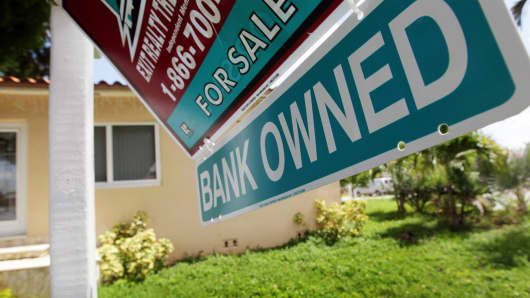The effect of loose lending during the last housing boom was abundantly clear: Nearly 8 million U.S. homes fell into foreclosure. The response was a slew of new lending rules under the Dodd-Frank financial reform law, and the result was a credit lockdown that continues today, nearly five years after the legislation was enacted.
“For lenders this is all about paperwork, verification and doing a lot of the grunt work that was ignored or passed over before the crisis,” said Jaret Seiberg, a managing director at financing firm Guggenheim Securities.
The rules fill thousands of pages and have cost lenders millions of dollars in labor and software to revamp their systems in compliance, but at face value, they’re pretty simple. Highly risky loan products, like negative amortization mortgages, are now banned. Borrowers must document their employment and debt levels. Lenders must disclose all the costs involved in each loan, and, perhaps most important, lenders must verify a borrower’s ability to repay the mortgage.
That last one may sound ridiculous, but it was the fundamental reason for the financial crisis in housing. Borrowers were given loans they could never repay.
“If you’re a high-quality credit consumer, Dodd-Frank just made it a much bigger pain in the butt to get a loan. You’ve got to fill out more paperwork, you’ve got to dig up more tax returns,” said Seiberg. “You’ve got to find information related to retirement accounts, stuff that was never asked for before. But if you’re on the low end of the spectrum, it has made it tougher to get that mortgage.”
So tough that the average FICO credit score on loans made today are the highest in history. Tight credit, though, is blamed for a still-falling homeownership rate, now at the lowest in a quarter century.
“The biggest misconception is that you need a big down payment to buy a house. It’s just not correct. What has changed is not the down payment, it is the credit and the ability to repay rule. Beyond that it’s the documentation piece,” said Craig Strent, CEO of Maryland-based Apex Home Loans. “It’s not hard to qualify, it’s hard to get through the process because of the massive amounts of additional documentation that is now required.”
Borrowers, however, still complain that it is not just the process, but the level of creditworthiness that is keeping them out of the homebuying market; even the Federal Reserve chair, readying to raise interest rates, says credit is too tight.
“Demand for housing is still being restrained by limited availability of mortgage loans to many potential homebuyers,” said the central bank’s chair, Janet Yellen, in testimony to the Senate Banking Committee on Wednesday.
Tight credit is also blamed for a shift in the lending landscape. Large bank lenders are moving out, and independent, nonbank lenders are moving in. Nonbanks now make up 43 percent of mortgage lending today, up from just 10 percent in 2009, according to Inside Mortgage Finance, an industry publication.
“Banks consolidated massively. The big four are so well-diversified that revenue stream from mortgages is not part of their headline strategy,” said Anthony Hsieh, chairman and CEO of California-based loanDepot, a nonbank lender that has grown dramatically in just the past year.
Private sector investors have not returned to the mortgage market. Loans backed by government entities Fannie Mae, Freddie Mac and the FHA make up more than 90 percent of all new loans today, a historically high share. During the housing boom they were barely one-third of the market.
“I think Dodd-Frank, not only does it add complexity, but it adds a lot of confusion,” said Hsieh.
It also adds significant costs in time and labor. Lenders like Apex Home Loans have had to hire dozens of additional staff just to comply with new rules.
read more…
http://www.cnbc.com/2015/07/16/how-dodd-frank-changed-housing-for-good-and-bad.html







 Savills
Savills


